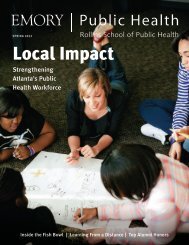returning quality to life - Woodruff Health Sciences Center - Emory ...
returning quality to life - Woodruff Health Sciences Center - Emory ...
returning quality to life - Woodruff Health Sciences Center - Emory ...
Create successful ePaper yourself
Turn your PDF publications into a flip-book with our unique Google optimized e-Paper software.
scar from the previous delivery can rupture.<br />
Although rare, a rupture can be catastrophic,<br />
risking both mother and baby.”<br />
Artificial reproductive technology has<br />
led <strong>to</strong> more twin and<br />
triplet pregnancies,<br />
which have a much<br />
higher rate than<br />
single pregnancies of<br />
C-section and early<br />
delivery.<br />
Likewise, the rise<br />
of maternal obesity<br />
and maternal diabetes<br />
is driving up the<br />
number of C-sections<br />
because of the<br />
increased risks during<br />
labor and delivery.<br />
Finally, whether<br />
<strong>to</strong> have a C-section<br />
or not also can come<br />
down <strong>to</strong> the mother’s<br />
preference—depending<br />
on her <strong>life</strong>style,<br />
energy level, and fitness.<br />
Some women<br />
choose C-sections<br />
because they believe<br />
the procedure may<br />
reduce the chance of<br />
future urinary incontinence<br />
or sexual dysfunction.<br />
Money and legal<br />
considerations also<br />
come in<strong>to</strong> play. The<br />
current medical payment<br />
system encourages<br />
C-sections<br />
because they are a quick, controlled method<br />
of delivery. “The obstetrician can do a<br />
C-section under very controlled circumstances<br />
in less than half an hour, while vaginal<br />
delivery can consume much more of the<br />
obstetrician’s time,” says Jain.<br />
C-sections also decrease the likelihood of<br />
medical malpractice lawsuits. Obstetricians<br />
as a group are especially vulnerable <strong>to</strong> legal<br />
action. If a baby has health problems after<br />
Jain’s research focuses on how newborns’<br />
lungs clear fluid. In collaboration with<br />
<strong>Emory</strong> physiologist Douglas Ea<strong>to</strong>n, he<br />
works on a small molecule in the lung<br />
called ENaC, or epithelium sodium channel<br />
molecule. “This molecule sits in the<br />
lungs and helps absorb sodium <strong>to</strong> help<br />
clear fluid from the lungs,” Jain says.<br />
“What triggers the fluid absorption is an<br />
enormous release of steroids during labor.<br />
So in elective C-sections we’re contemplating<br />
a trial in which we give the mother<br />
a shot of steroids <strong>to</strong> mimic what would<br />
have happened in spontaneous labor <strong>to</strong><br />
help the baby’s lungs clear out fluid.<br />
“We may not be able <strong>to</strong> solve all the<br />
problems, but at least we can begin <strong>to</strong><br />
take care of some of them.”<br />
a delivery, the obstetrician is often held<br />
responsible, but if the mother asks or consents<br />
<strong>to</strong> a C-section, the physician’s level<br />
of responsibility shifts. But so does the<br />
genuine due date.<br />
On-time<br />
delivery?<br />
Determining gestational<br />
age is difficult,<br />
and estimates of due<br />
dates are accurate<br />
within only a week<br />
or two of the genuine<br />
date. A C-section<br />
may lop off as much<br />
as two weeks of fetal<br />
development, which<br />
can lead <strong>to</strong> short- and<br />
long-term adverse<br />
effects, especially in<br />
the lungs and maybe<br />
the brain.<br />
“For thousands of<br />
years, Mother Nature’s<br />
clock has been the<br />
best predic<strong>to</strong>r of fullterm<br />
gestation,” says<br />
Jain. “Anytime we<br />
bypass that, we can<br />
end up having babies<br />
delivered a week or<br />
two early.”<br />
That’s important<br />
because in the last<br />
five or six weeks of<br />
gestation, the lungs<br />
become ready <strong>to</strong><br />
breathe. “I liken it <strong>to</strong><br />
a plane preparing for<br />
a safe landing,” says Jain. “The ‘landing gear’<br />
includes a sufficient maturity of the lungs <strong>to</strong><br />
be able <strong>to</strong> transition <strong>to</strong> air breathing and <strong>to</strong><br />
rapidly clear lung fluid as well as taking over<br />
the many functions that the mother’s body<br />
had regulated for the baby.”<br />
While the lungs are full of fluid at birth,<br />
full-term babies can clear it rapidly while<br />
early-term babies often cannot. “Labor and<br />
delivery are part of a transient burst of activ-<br />
ity of chemicals and hormones that prepares<br />
the baby for newborn transition,” says Jain.<br />
One of those chemical cascades involves<br />
the hormone oxy<strong>to</strong>cin. Released by the<br />
mother, oxy<strong>to</strong>cin helps regulate cervical dilation<br />
and uterine contractions during labor.<br />
The hormone also paves the way for breastfeeding<br />
and pair bonding. For this reason,<br />
mothers who have had a C-section may have<br />
difficulty in initiating breastfeeding.<br />
And it’s not just the mother who releases<br />
hormones. The fetus does <strong>to</strong>o. Just around<br />
the time of spontaneous labor or slightly<br />
before, the fetus releases corticosteroids,<br />
a class of steroids crucial <strong>to</strong> fetal development—especially<br />
the lungs. In fact, the fetus<br />
continues <strong>to</strong> release corticosteroids throughout<br />
labor and even in<strong>to</strong> early birth.<br />
“From a pediatrician’s standpoint, the<br />
most important thing for parents <strong>to</strong> remember<br />
is that one out of 10 Caesarian babies<br />
get admitted <strong>to</strong> the ICU,” says Jain. “Most of<br />
them come in<strong>to</strong> the ICU with an inability <strong>to</strong><br />
transition <strong>to</strong> air breathing. They often start<br />
breathing fast because the lung fluid has not<br />
been cleared.”<br />
Additionally, catecholomines, the figh<strong>to</strong>r-flight<br />
hormones, rise <strong>to</strong> astronomical<br />
levels during labor, says Jain. Like corticosteroids,<br />
they <strong>to</strong>o play an essential role in maturation<br />
of the fetus.<br />
Researchers are just now beginning <strong>to</strong><br />
look at the long-term consequences of elective<br />
C-sections. There is growing evidence<br />
that asthma, celiac disease, and neurologic<br />
difficulties may be linked <strong>to</strong> foregoing labor<br />
and vaginal delivery. That’s why, says Jain,<br />
parents must clearly understand and carefully<br />
consider the risks and benefits of a<br />
C-section before making a decision <strong>to</strong> choose<br />
one. Because the decision of whether <strong>to</strong> have<br />
a vaginal birth or C-section depends on so<br />
many variables, he believes the doc<strong>to</strong>r is the<br />
best judge. EH<br />
WEB CONNECTION To hear a podcast<br />
about implications for the increase in<br />
C-sections, visit http://bit.ly/csections.<br />
Winter 2011 17
















